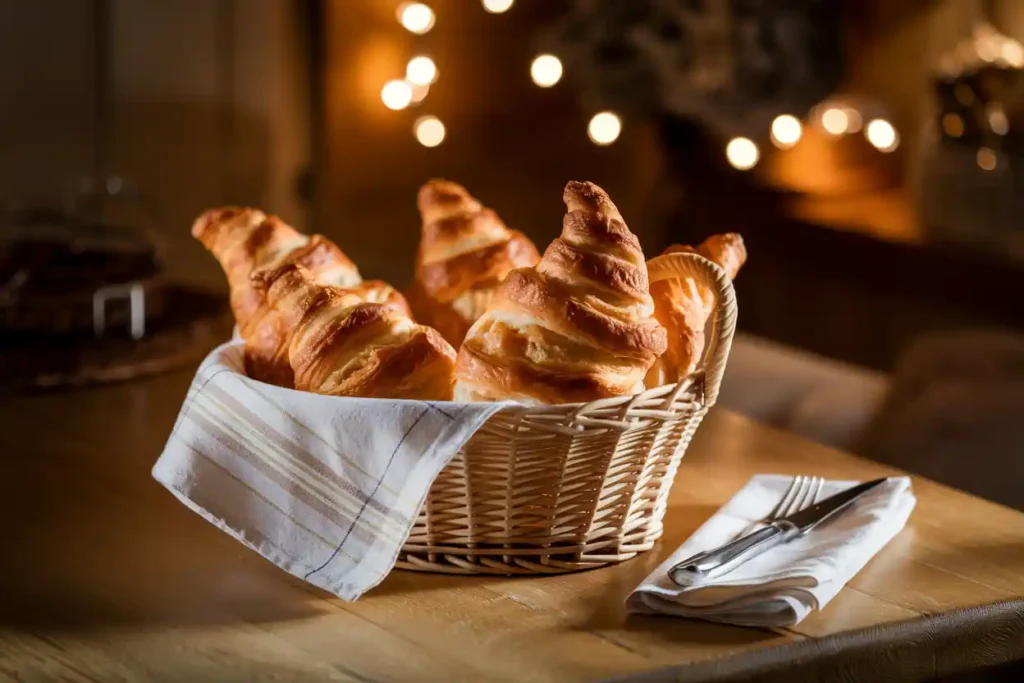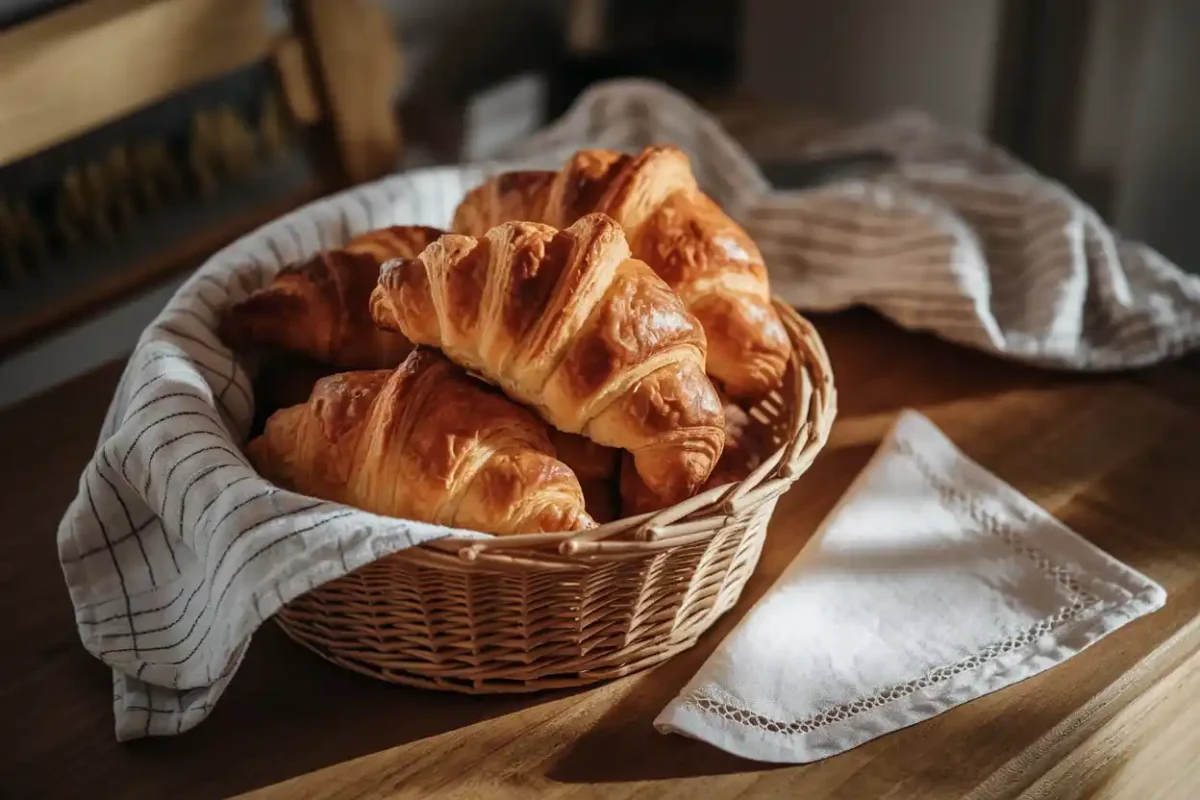When it comes to breakfast pastries, few delights can rival the allure of a croissant. But have you ever heard of its Swiss cousin, the Gipfel croissant? This unique pastry has captured the hearts of Swiss locals and travelers alike, offering a subtle twist on the classic croissant. In this article, we’ll dive deep into the Gipfel croissant—exploring its history, cultural roots, and what makes it distinct from its French counterpart. Whether you’re curious about its origins, eager to learn how to make it at home, or just looking for the best places to try one, we’ve got you covered. Let’s begin with an introduction to this fascinating pastry!
Table of contents
- What Is a Gipfel Croissant?
- History and Cultural Significance
- Gipfel Croissant vs. Traditional Croissant
- How to Make Gipfel Croissant at Home
- Where to Find Authentic Gipfel Croissants
- Frequently Asked Questions
- The Future of Gipfel Croissant in Baking
- Exploring the Role of Gipfel Croissant in Swiss Cuisine
- How the Gipfel Croissant Stands Out in a Competitive Market
- Conclusion and Final Thoughts
What Is a Gipfel Croissant?
The Origin of Gipfel and Its Name
The Gipfel croissant, also known simply as Gipfeli in Switzerland, takes its name from the German word “Gipfel,” meaning “summit” or “peak.” The name reflects its crescent shape, which resembles a small mountain peak. While it shares similarities with the classic French croissant, the Gipfeli has a distinct identity rooted in Swiss culinary traditions. Emerging in the 19th century, it quickly became a breakfast staple in Swiss households and bakeries.
How Gipfel Differs from Traditional Croissants
At first glance, you might mistake a Gipfel croissant for a regular croissant. However, there are subtle differences. For starters, the Gipfeli is less buttery and has a slightly firmer texture, making it less flaky than its French counterpart. Unlike the croissant, which exudes a rich and indulgent flavor, the Gipfeli is often milder, making it a versatile option for sweet or savory pairings.
Another notable distinction is its size and shape. While croissants tend to have a larger, looser crescent form, Gipfeli are typically smaller and more compact. This difference gives them a unique mouthfeel that complements Swiss breakfasts perfectly.
Key Ingredients in a Gipfel Croissant
The Gipfel croissant stands out not only for its flavor but also for its simplicity. Traditional recipes call for flour, milk, yeast, a touch of sugar, and only a modest amount of butter—unlike the heavily laminated dough used for croissants. Some variations even incorporate additional ingredients like cream or sourdough starter for added depth.
This minimalist ingredient list contributes to the pastry’s balanced flavor and firmer texture, making it ideal for enjoying with butter, jam, or cheese. Whether served plain or with toppings, the Gipfeli is the epitome of understated elegance in the world of pastries.
History and Cultural Significance
The Evolution of Gipfeli in Swiss Culture
The Gipfel croissant holds a special place in Swiss breakfast traditions, with its origins tracing back to the 19th century. Unlike its French counterpart, the Gipfeli quickly adapted to Swiss tastes, emphasizing simplicity and mild flavors. It became a beloved item, often enjoyed with coffee or tea.
This pastry isn’t just a breakfast item; it’s a cultural symbol. In Switzerland, sharing a basket of Gipfeli signifies warmth and hospitality. The compact, less buttery design reflects the pragmatic and wholesome Swiss ethos, making it a staple at home, cafes, and even business meetings.
Traditional Versus Modern Takes on Gipfeli
Over the decades, the Gipfel croissant has evolved. Traditionally made with minimal butter and sugar, it leaned toward a balanced, less indulgent treat. Modern variations, however, embrace creativity. From fillings like chocolate and almond paste to savory options with cheese or ham, the Gipfeli continues to delight diverse palates.
While innovation is celebrated, purists often argue that the charm of a true Gipfeli lies in its simplicity. This debate keeps the tradition alive, with both classic and modern recipes thriving in bakeries worldwide.
Gipfeli in Global Baking Traditions
The global rise of croissant-inspired pastries has spotlighted the Gipfel croissant. Its firmer texture and balanced flavor make it a popular alternative for those seeking a lighter pastry. The Gipfeli has even influenced recipes in other cuisines, inspiring crescent-shaped pastries that prioritize subtlety over richness.
By staying true to its roots while embracing innovation, the Gipfel croissant has carved a unique niche in the ever-evolving world of baking.
For more insights into crescent-shaped pastries and how they influence international menus, check out Puff Pastry Cheese Twists.
Gipfel Croissant vs. Traditional Croissant
Shape and Texture: Key Visual and Textural Differences
At first glance, the Gipfel croissant and French croissant seem similar, but their distinctions are evident upon closer inspection. The Gipfeli is smaller, more compact, and has a denser texture, making it less flaky than its French sibling. Its crescent shape is often tighter, symbolizing the precision in Swiss baking.
While French croissants boast layers that almost melt in your mouth, the Gipfeli offers a firmer bite, ideal for those who prefer pastries with a slight chewiness. This texture also makes the Gipfel croissant more versatile for pairing with spreads or toppings.
Flavor Profiles and Variations
The Gipfel croissant offers a milder taste, with a subtle sweetness that doesn’t overpower. This makes it an excellent choice for both sweet and savory accompaniments. On the other hand, French croissants exude richness from their buttery layers, delivering a luxurious experience in every bite.
Modern variations of both pastries introduce exciting flavors. While chocolate and almond-filled croissants are classics, Gipfeli often feature local Swiss ingredients like Emmental cheese or apricot preserves, creating a fusion of tradition and creativity.
Regional Preferences and Popularity
Preferences for the Gipfel croissant and traditional croissants vary by region. In Switzerland, the Gipfeli is a breakfast icon, often preferred for its lightness and practicality. In contrast, the French croissant reigns supreme in countries where indulgence and butter-rich flavors are prized.
Interestingly, the growing trend toward health-conscious eating has brought the Gipfel croissant into the spotlight. Its balanced composition makes it appealing to those who want to enjoy pastries without excessive richness.
For those who appreciate a lighter alternative to buttery pastries, try exploring recipes like Sourdough Pancakes for a similarly balanced breakfast option.
How to Make Gipfel Croissant at Home
Essential Ingredients and Tools
Creating the perfect Gipfel croissant at home requires simple, accessible ingredients and a few essential tools. Unlike the traditional croissant, the Gipfeli calls for less butter, making it less daunting for first-time bakers. Here’s what you’ll need:
- Ingredients: All-purpose flour, milk, yeast, sugar, salt, and a moderate amount of butter. Optional add-ins include sourdough starter for depth or cream for softness.
- Tools: A rolling pin, mixing bowls, and a pastry cutter are indispensable. For even baking, a reliable oven with consistent heat is essential.
These tools and ingredients come together to create a pastry that’s both satisfying and easy to master.
Step-by-Step Recipe for Gipfel Croissants
- Prepare the Dough: Combine the yeast, sugar, and warm milk, allowing the mixture to activate. Gradually mix in the flour and salt, kneading until the dough is smooth and elastic.
- Rest the Dough: Cover and let it rest in a warm spot until it doubles in size.
- Shape the Pastry: Roll out the dough into a rectangle, fold it to create layers, and roll it out again. Cut the dough into triangles and roll each into a tight crescent shape.
- Bake to Perfection: Place the crescents on a baking sheet, brush with egg wash, and bake in a preheated oven until golden brown.
Common Mistakes and How to Avoid Them
Even the most skilled bakers face challenges. To avoid dense or unevenly baked Gipfeli:
- Ensure the yeast is fresh and active.
- Don’t rush the resting phase; it’s crucial for a light texture.
- Roll the dough evenly to ensure consistent baking.
For more tips on creating pastries, you might enjoy our guide to Puff Pastry Cheese Twists.
Where to Find Authentic Gipfel Croissants
Best Bakeries for Gipfeli in Switzerland
If you’re visiting Switzerland, sampling authentic Gipfel croissants is a must. Renowned bakeries like Confiserie Sprüngli and Zopfbeck offer exquisite Gipfeli, crafted with traditional techniques and premium ingredients. These bakeries are celebrated for preserving the essence of Swiss pastry-making while catering to modern tastes.
International Spots Offering Swiss Gipfeli
While Gipfeli are quintessentially Swiss, their appeal has reached global audiences. Specialty bakeries in cities like New York, London, and Tokyo are now offering Gipfel croissants, highlighting their growing popularity. These establishments often blend traditional Swiss recipes with local flavors, resulting in unique variations that honor the original.

Ordering Gipfeli Online
For those who can’t travel, many Swiss bakeries offer online delivery of freshly baked Gipfeli. Brands like New Glarus Bakery ship these delectable pastries to customers worldwide, ensuring the authentic taste of Switzerland is just a click away.
If you’re interested in exploring other baked treats, consider checking out Creamy Strawberry Crepes for another delightful breakfast option.
Frequently Asked Questions
What Is the Difference Between a Croissant and a Gipfeli?
While both pastries share a crescent shape, the Gipfel croissant differs significantly from the traditional French croissant. The Gipfeli is less buttery, resulting in a firmer, less flaky texture. This makes it a lighter option, ideal for pairing with a variety of sweet or savory accompaniments. French croissants, on the other hand, are renowned for their rich, buttery layers that almost melt in your mouth. Each pastry reflects its country’s distinct culinary style, making both worth trying.
What Is the Swiss Version of a Croissant?
The Swiss version of a croissant is the beloved Gipfeli. It’s a staple at Swiss breakfasts and often enjoyed with coffee or tea. The Gipfel croissant embodies Swiss values of simplicity and subtle flavors, making it a versatile choice for a variety of occasions. Its modest butter content and tighter crescent shape make it uniquely Swiss, a reflection of the country’s culinary heritage.
What Are the Best Croissants in the World?
When it comes to the best croissants, French bakeries typically dominate the rankings. However, the Gipfel croissant deserves its own spotlight for its distinct charm. While Parisian croissants boast indulgent layers of butter, the Gipfeli offers a balanced flavor and firmer bite, appealing to those who prefer subtler pastries. Swiss bakeries like Confiserie Sprüngli are celebrated for their exceptional Gipfeli, earning global recognition.
What Are Croissants Called in Vienna?
In Vienna, the precursor to the croissant is known as the kipferl. This pastry inspired the French croissant, evolving over time into the buttery layers we recognize today. Interestingly, the Gipfel croissant shares similarities with the kipferl, particularly in its firmer texture and understated flavors, highlighting a shared European baking heritage.
The Future of Gipfel Croissant in Baking
Trends in Modern Pastry Innovation
As global tastes shift toward lighter, healthier options, the Gipfel croissant is gaining popularity. Bakers are experimenting with creative twists, incorporating whole grains, alternative flours, and unique fillings like seasonal fruits or artisanal cheeses. These innovations preserve the essence of the Gipfeli while appealing to modern consumers seeking exciting, wholesome flavors.
Gipfeli and Healthier Baking Options
The Gipfel croissant aligns with the trend toward mindful eating. Its moderate butter content and simpler preparation make it a lighter alternative to the traditional croissant. Bakers are also exploring vegan and gluten-free versions of the Gipfeli, ensuring that this classic Swiss treat is accessible to a wider audience without compromising on taste.
The Potential of Gipfeli in Global Markets
The Gipfel croissant has the potential to become a global pastry sensation. With its balanced flavor and versatility, it caters to a variety of palates. International bakeries and cafes are increasingly featuring Gipfeli on their menus, introducing this Swiss classic to new audiences. As interest grows, the Gipfel croissant could join the ranks of globally loved pastries.
Exploring the Role of Gipfel Croissant in Swiss Cuisine
A Breakfast Staple Across Switzerland
In Switzerland, the Gipfel croissant is much more than just a pastry—it’s a cherished part of daily life. Whether at home, in a bustling cafe, or during leisurely weekend brunches, Gipfeli make frequent appearances. Their balanced flavor profile pairs well with various spreads, from fruity jams to savory cheeses, making them versatile enough for any meal.
Unlike heavier pastries, the Gipfel croissant provides a light start to the day. Its simplicity mirrors the Swiss approach to food: high quality, wholesome, and not overly indulgent. This widespread popularity ensures that bakeries across Switzerland remain dedicated to perfecting their Gipfeli offerings.
Celebrating Gipfeli in Festivals and Traditions
Swiss food festivals often showcase the Gipfel croissant, highlighting its role in the nation’s culinary identity. In many regions, you’ll find bakeries hosting workshops, teaching visitors how to craft these iconic pastries. These events celebrate the Gipfeli as a symbol of Swiss craftsmanship and tradition, drawing both locals and tourists eager to learn and taste.
Its presence at cultural gatherings reinforces the Gipfel croissant as more than just a snack—it’s a connection to Swiss heritage, uniting communities over a shared love for this humble pastry.
How the Gipfel Croissant Stands Out in a Competitive Market
The Appeal of Simplicity and Balance
In a world of ever-more decadent pastries, the Gipfel croissant holds its own by embracing simplicity. While many pastries aim to dazzle with excess butter or sugar, the Gipfeli charms with its understated elegance. This quality makes it a refreshing alternative, particularly for health-conscious consumers who seek indulgence without overindulgence.
Additionally, its versatility allows it to cater to diverse tastes. Whether enjoyed plain, filled with a touch of chocolate, or topped with seeds, the Gipfel croissant effortlessly adapts to modern palates while staying true to its roots.
Meeting the Challenges of Modern Baking
As the pastry market grows increasingly competitive, the Gipfel croissant faces the challenge of standing out. However, its unique qualities—lighter texture, subtle flavor, and strong cultural ties—give it a lasting edge. Bakers around the world are also reinterpreting the Gipfeli, ensuring it remains relevant and appealing to new generations.
This adaptability has cemented the Gipfel croissant as a timeless favorite, proving that even in a competitive market, authenticity and simplicity resonate deeply with consumers.
Conclusion and Final Thoughts
The Gipfel croissant is a testament to the beauty of simplicity and tradition. From its roots in Swiss culture to its growing global appeal, this unique pastry has carved a niche in the hearts of pastry lovers everywhere. Whether enjoyed as part of a hearty Swiss breakfast, crafted at home, or discovered in bakeries abroad, the Gipfeli stands out with its subtle flavors and versatility. As baking trends evolve, the Gipfel croissant continues to bridge the gap between heritage and innovation, proving that timeless recipes never go out of style. It’s truly a pastry worth savoring.

